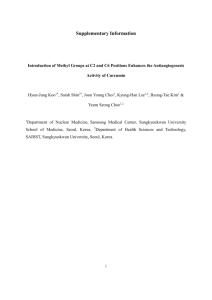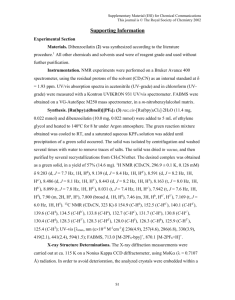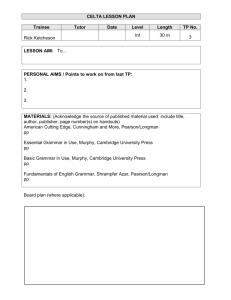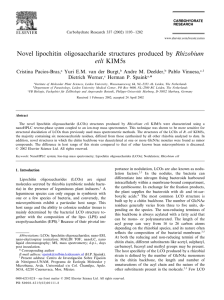Supplementary Materials and Methods (doc 42K)
advertisement
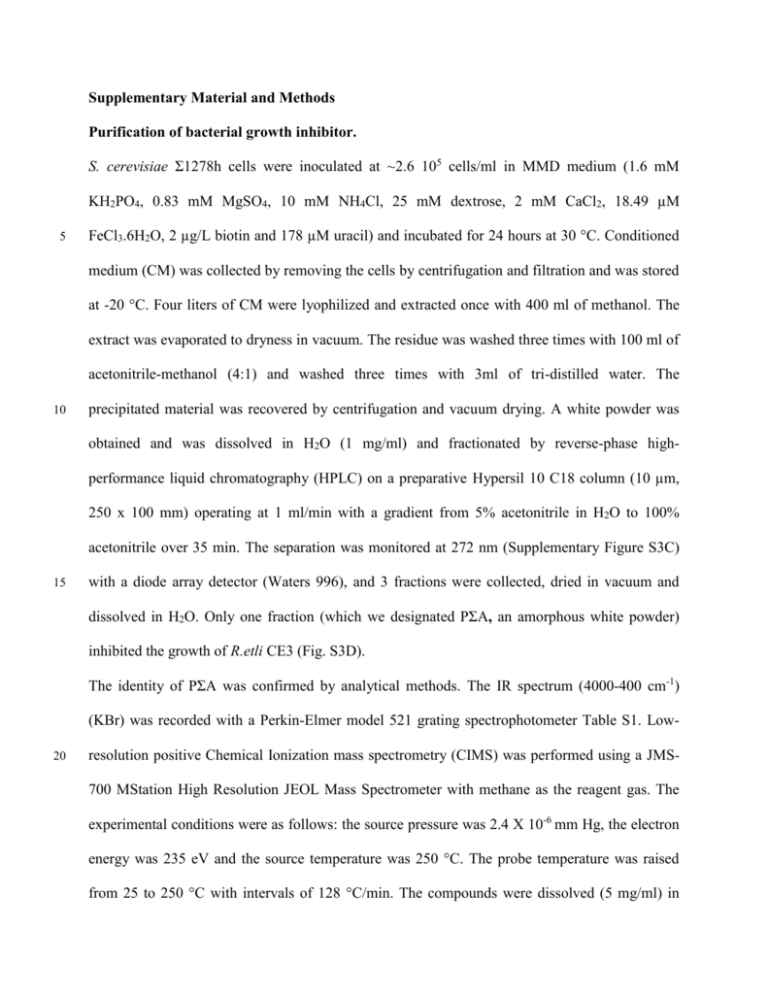
Supplementary Material and Methods Purification of bacterial growth inhibitor. S. cerevisiae Σ1278h cells were inoculated at ~2.6 105 cells/ml in MMD medium (1.6 mM KH2PO4, 0.83 mM MgSO4, 10 mM NH4Cl, 25 mM dextrose, 2 mM CaCl2, 18.49 µM 5 FeCl3.6H2O, 2 µg/L biotin and 178 µM uracil) and incubated for 24 hours at 30 °C. Conditioned medium (CM) was collected by removing the cells by centrifugation and filtration and was stored at -20 °C. Four liters of CM were lyophilized and extracted once with 400 ml of methanol. The extract was evaporated to dryness in vacuum. The residue was washed three times with 100 ml of acetonitrile-methanol (4:1) and washed three times with 3ml of tri-distilled water. The 10 precipitated material was recovered by centrifugation and vacuum drying. A white powder was obtained and was dissolved in H2O (1 mg/ml) and fractionated by reverse-phase highperformance liquid chromatography (HPLC) on a preparative Hypersil 10 C18 column (10 µm, 250 x 100 mm) operating at 1 ml/min with a gradient from 5% acetonitrile in H2O to 100% acetonitrile over 35 min. The separation was monitored at 272 nm (Supplementary Figure S3C) 15 with a diode array detector (Waters 996), and 3 fractions were collected, dried in vacuum and dissolved in H2O. Only one fraction (which we designated PΣA, an amorphous white powder) inhibited the growth of R.etli CE3 (Fig. S3D). The identity of PΣA was confirmed by analytical methods. The IR spectrum (4000-400 cm-1) (KBr) was recorded with a Perkin-Elmer model 521 grating spectrophotometer Table S1. Low- 20 resolution positive Chemical Ionization mass spectrometry (CIMS) was performed using a JMS700 MStation High Resolution JEOL Mass Spectrometer with methane as the reagent gas. The experimental conditions were as follows: the source pressure was 2.4 X 10-6 mm Hg, the electron energy was 235 eV and the source temperature was 250 °C. The probe temperature was raised from 25 to 250 °C with intervals of 128 °C/min. The compounds were dissolved (5 mg/ml) in 25 methanol/H2O (2:1 v/v) and pH adjusted to 7 with NaOH. The CIMS of PΣA was identical (Supplementary Figure S4) to the OA spectrum (Sigma Aldrich Cat # O2750). NMR spectra were recorded using a Jeol EX 400 Eclipse instrument operating at 161.997 MHz. The 31P NMR chemical shift is referred to as 85 % H3PO4. The complete structure of PΣA was finally solved by interpreting one- and two-dimensional NMR spectra (1H and 30 13 C NMR and gHSQC; Supplementary Table S5). Overall, the results of these analyses indicated that the molecule responsible for inhibiting the growth of R.etli CE3 was OA. Quantification of orotic acid and organic acids. HPLC organic acids analysis was performed as previously described (Encarnación et al., 1995). For the quantification of OA, the culture media were filtered through membrane filters (type HA, 35 0.45-mm pore size; Millipore Corp., Mildford, MA, USA), and 20µl samples were analyzed by HPLC. The HPLC system (Waters Chromatography Division, Millipore Corp.) was equipped with an isocratic pump (Waters 510) and a diode array detector (Waters 996). The analyses were performed isocratically at 0.9 ml/min and 60 °C with three Shodex Ion-Pak KC-811 columns (300 x 8 mm i.d.). OA and organic acids were eluted with a mobile phase of 1.25 mM HClO4 and 40 were reacted with 0.2 mM bromothymol blue–15 mM Na2HPO4–2 mM NaOH buffer (pH 10.5) through the reaction coil. Organic acid was detected at 436 nm and OA at 272 nm. The method linearity for OA quantification was determined with 11 aqueous standard solutions (5, 10, 20, 30, 40, 50, 60, 70, 80, 90 and 100 µg/ml). Three injections were performed for each solution. The linear regression coefficient between the theoretical and measured concentrations was calculated. 45 Orotic acid and selected bacterial strains assays. R. etli strains were tested against OA using the diffusion assay. Overnight, cultures of each test strain in PY-D were diluted 1000-fold into PY-D containing 1.5 % agar and poured into standard Petri dish plates. Five micrograms of OA was placed on top of the agar. The plates were incubated at 30°C for 24 hours, and the presence or absence of an inhibition zone was monitored 50 visually. In addition, the assay was conducted in liquid media. R. etli strains were tested in YP-D. Inocula for each test strain was prepared by suspending a colony selected from an agar plate in 5 ml of PY-D in 50 ml bacterial culture tubes. These were grown overnight and then adjusted to ~1x 108 cells/ml. These cell suspensions were used to inoculate 1 ml of appropriate medium at ~8 x 106 cells/ml. The cultures were supplemented with 50 µl of medium (negative control), 50 µl of 55 H2O (negative control) or 50 µl of OA at either 2 mg/mL or 10 mg/ml. The assay for each test strain was conducted in triplicate. The tubes were incubated with shaking (200 r.p.m.) for 24 hours at 30°C, and each OD600 nm was determined. No significant differences in OD600 nm were observed in the wells supplemented with medium vs. those supplemented with H2O. Inhibition of OA effects by C4-carboxylates and purines. 60 The R. etli CE3 cells were grown overnight in PY medium. These cell suspensions were used to inoculate 1 ml of PYD medium at ~4 x 106 cells/ml. The culture medium was supplemented with 100 µg/ml OA, and the metabolites were tested as inhibitors (Supplementary Figure S5). The medium pH was adjusted to 7 with NaOH or HCl and sterilized by filtration. The tubes were incubated with shaking (200 r.p.m.) for 24 hours at 30°C, Bacterial concentrations in C.F.U./ml 65 were determined to evaluate growth. Proteomic analysis of R. etli CE3. Cultures were prepared as described in the transcriptome experiments above. After 4 hours of growth in MM-D medium, the cells were exposed to 50 µg/ml OA for 1 hour, collected by centrifugation, flash-frozen and stored in liquid nitrogen. The cells were washed with 1X 70 phosphate-buffered saline. Total protein was obtained by sonication at 24 kHz for 30 s in the on position and 1 min in the off position for five cycles at 4°C using a Vibra Cell (Sonics, United States) in the presence of a protease inhibitor (Complete tablets; Roche Diagnostics GmbH, Mannheim, Germany). Protein isolation was performed using phenol extraction (Encarnación et al., 2003). Protein solubilization, preparative two-dimensional gel electrophoresis (2-DGE), 2D75 Gel image analysis data and protein identifications (MALDI-TOF-MS) were performed as previously described (Encarnación et al., 2003). GS determination. Cultures were prepared as described in the proteome experiments. The cells were exposed to 50 µg/ml of OA for 1 hour. GS was measured by transferase activities as described by Bender et al. 80 (1997). The specific activities were expressed as units (U) per milligram of protein; 1 U represents 1 nM of γ-glutamylhydroxamate produced per min. The two GS activities were distinguished by their different heat stabilities for 1 hour at 50°C and their different sedimentations on sucrose density gradients as described below. The adenylation state of GSI was determined by calculation of the ratio of transferase activities measured in the presence and 85 absence of added Mg2 as described by Shapiro and Stadtman (Darrow & Knotts, 1977). References. Bender RA, Janssen KA, Resnick AD, Blumenberg M, Foor F, Magasanik B. (1977). Biochemical parameters of glutamine synthetase from Klebsiella aerogenes. J Bacteriol 129: 90 1001–1009. Darrow RA, Knotts RR. (1977). Two forms of glutamine synthetase in free-living root-nodule bacteria. Biochem Biophys Res Commun78: 554–559. Encarnación S, Dunn M, Willms K, Mora J, Dunn M, Willms K, et al. (1995). Fermentative and aerobic metabolism in Rhizobium etli. J Bacteriol 177: 3058-3066. 95 Encarnación S, Guzmán Y, Dunn MF, Hernández M, Vargas MDC, Mora J. (2003). Proteome analysis of aerobic and fermentative metabolism in Rhizobium etli CE3. Proteomics 3: 1077– 1085.
